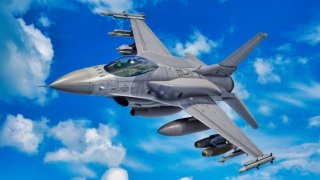The F-16 Block 70/72 Fighter Is the Most Advanced 'Fighting Falcon' Ever
Aviation buffs and military officials alike widely respect the latest F-16 iteration to be produced by Lockheed Martin. The Block 70 and Block 72 variants are equipped with the same capabilities and are only differentiated by their engine.
Meet the F-16 Block 70/72 - Last month, the most formidable F-16 Fighting Falcon variant successfully underwent testing to demonstrate its integration of the Viper Shield electronic warfare suite with the APG-84 Active Electronic Scanning Array (AESA) radar.
During the event held at manufacturer Lockheed Martin’s Systems Integration Lab on November 8, the test reportedly exposed Viper Shield with APG-83 energy for more than 12 hours, indicating that the radar pulse would not interfere with the electronic warfare suite’s functionality.
This impressive shield essentially provides protection and offensive EW capabilities for the formidable Fighting Falcon iteration. While the F-16 Block 70/72 may still be considered fourth-generation, this fighter can hold its own against some of the most cutting-edge and newer-generation jets across the globe.
An overview of the F-16 Fighting Falcon jet:
Following the U.S. military’s aerial experience in the Vietnam War, the need to prioritize air superiority fighters became widely recognized.
Moreover, increased and more advanced air-to-air training for fighter pilotswould be critical for future wars. Around this time, a fighter tactics instructor and a renowned mathematician co-developed the energy-maneuverability theory to map out how an airframe performs in combat. Ultimately, the Department of Defense would fund leading manufacturers General Dynamics and Northrop to research this cutting-edge concept further.
Specs and capabilities
While the new thrust-to-weight ratio concept was being studied, the Air Force already had all its eggs in the F-15 Eagle basket. Despite the study being deemed a threat to the service’s preferred fighter, it was understood that the existing Eagle program would not provide enough jets to satisfy the service’s array of missions. A new advanced fighter concept dubbed F-XX was created, culminating in the Lightweight Fighter.
By the early 1970s, engineers with General Dynamics developed the YF-16 prototype. Over the next few years, North Atlantic Treaty Organization (NATO) member states became more intrigued with the Lightweight Fighter program. By 1974, Belgium, the Netherlands, Norway, and Denmark formed the Multinational Fighter Program Group which helped escalate progress with the YF-16 prototype.
Feature-wise, the Fighting Falcon has a frameless bubble canopy, an ejection seat, and side-mounted control stick to better control while maneuvering. With 11 hardpoints and an internal M61 Vulcan cannon, the fighter can also pack a punch. Although the Falcon lacks the range possessed by its Eagle predecessor, the newer airframe costs less than half the price to be produced. In 1981, the Fighting Falcon was introduced to combat when Israel’s air force used its fleet of jets to obliterate Saddam Hussein’s Osirak nuclear reactor. Later, the U.S. Air Force’s fleet of Fighting Falcons would engage in combat during the Gulf War.
Block 70/72: What makes the latest F-16 variants so formidable?
The latest F-16 iteration to be produced is widely respected by aviation buffs and military officials alike. The Block 70 and Block 72 variants are equipped with the same capabilities and are only differentiated by their engine.
While the former is powered by the General Electric F110, the latter sports the Pratt & Whitney F100 engine. Both new variants have been fitted with an upgrade package that includes a modernized cockpit, conformal fuel tanks, advanced weapons and AN/APG-83 Scalable Agile Beam Radar. The advanced radar gives the Block 70/72 variants fifth-generation radar capabilities. In fact, this software has commonalities with the F-22 Raptor and F-35 Lightening II AESA radars. The fighters also feature a new, high resolution Center Pedestal Display which provides vital tactical imagery to pilots.
Manufactured by Lockheed Martin, the Automatic Ground Collision Avoidance System is also incorporated in the new Fighting Falcon iterations. Since its introduction to service in 2014, this system has saved the lives of many pilots as it is designed to reduce incidents known as controlled flight into terrain. Perhaps most significantly, the Block 70/72 variants have extended structural life abilities.
According to Lockheed Martin, these jets will be able to fly for 12,000 hours, more than double the amount of time given to previous Fighting Falcon variants: “That means a highly reliable, readily maintainable jet of at least 40 years of service life for most air forces, with no expected extended structural repairs throughout that entire lifetime. The conformal fuel tanks provide increased fuel and added range, without sacrificing the aerodynamic performance of the jet, along with an improved performance engine.”
In 2018, Bahrain became the first client state to procure the F-16 Block 70/72 fighters. Since then, Bulgaria and the Hashemite Kingdom of Jordan have also placed orders. Indonesia will also supplement its current fleet of Fighting Falcons with the newest variant in the near future.
About the Author
Maya Carlin is an analyst with the Center for Security Policy and a former Anna Sobol Levy Fellow at IDC Herzliya in Israel. She has by-lines in many publications, including The National Interest, Jerusalem Post, and Times of Israel. You can follow her on Twitter: @MayaCarlin.


